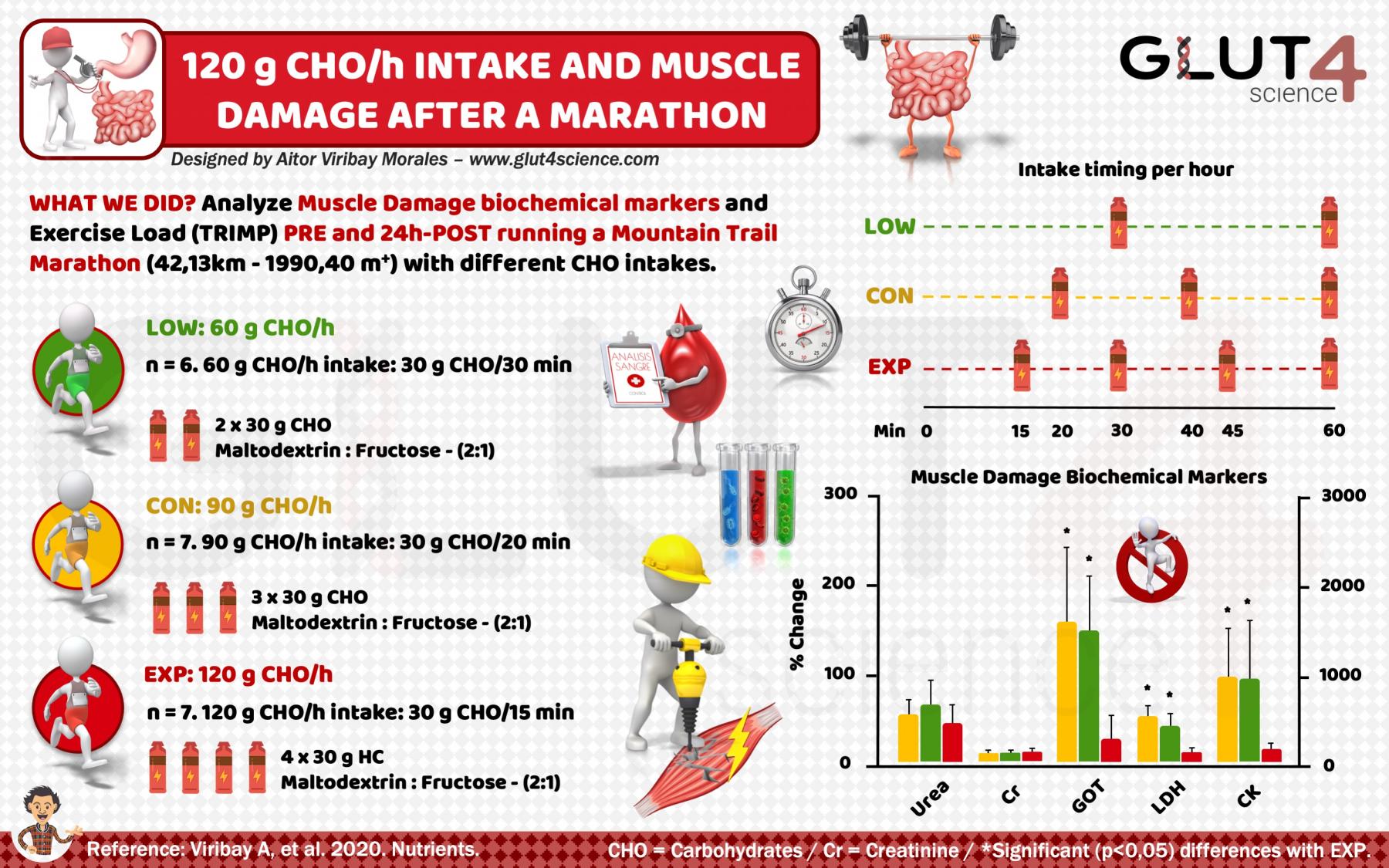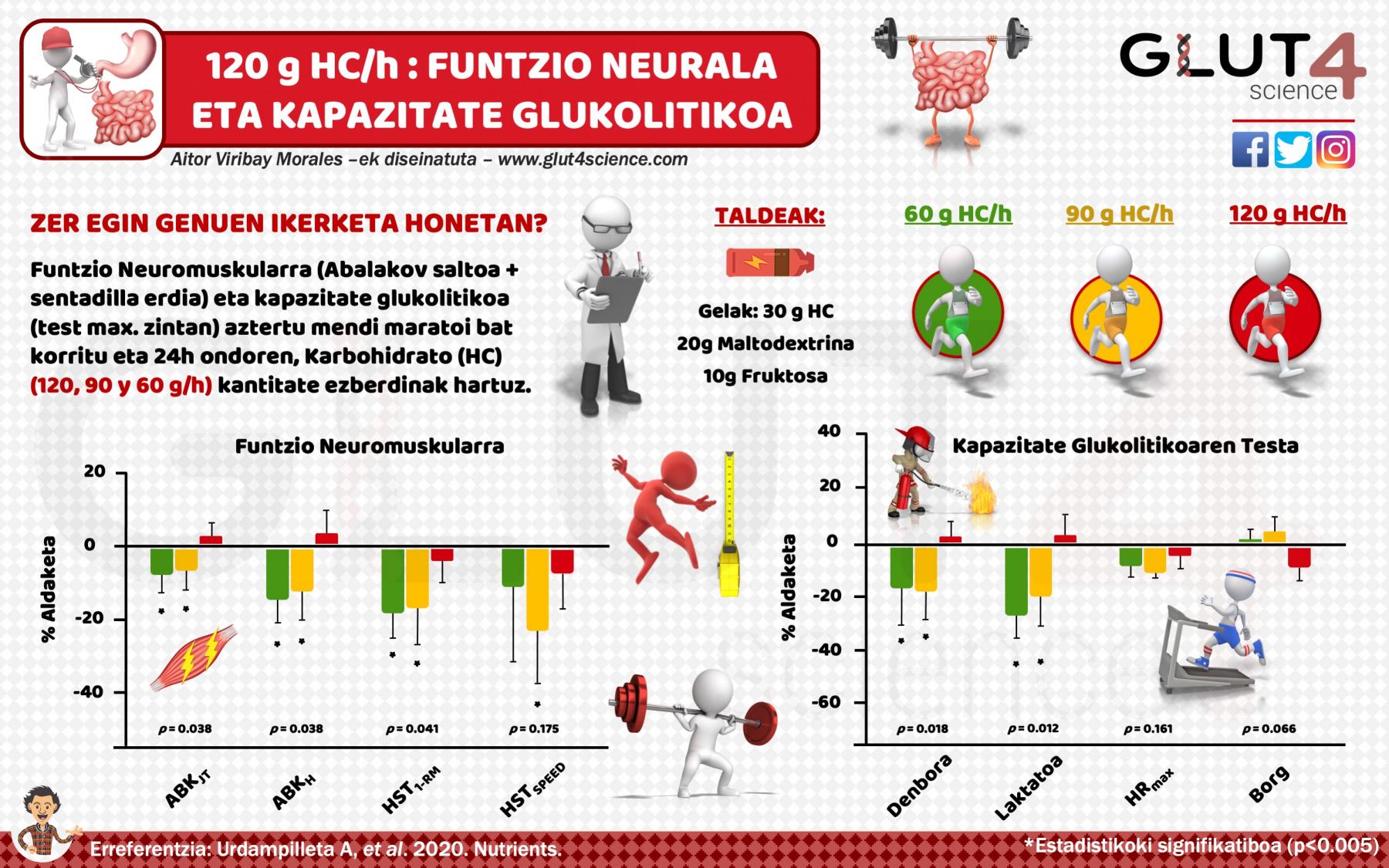120 grams of Carbohydrates per hour During Exercise Improve Recovery

Our new study has been published
Our latest research in the field of Carbohydrates (CHO) has been published this week in Nutrients (Q1). Some weeks ago (in May 2020), we (our researching group) published the first article of our research about the ingestion of higher CHO than currently recommended during exercise and its effects on different outcomes. It was an impressive work from a scientific and practical point of view, as we demonstrated that more than 90 CHO g/h could be ingested during exercise without reporting gastrointestinal problems and improving short-term recovery in a real scenario (Mountain Marathon). Although our results were not expected, the initial goal of this research was to give an answer to the following question:
Which is the definitive carbohydrate (CHO) intake target during endurance exercise like cycling or running? Could 120 g/h intake be possible and beneficial comparing with the current scientific recommendations of 60-90 g/h? Is science far behind the sports practice reality?
Based on what we practice and see in our everyday work with professional cyclists and athletes, we aimed to investigate the effects of a higher CHO intake (up to 120 g/h) in a randomized and well-designed trial. It finally led to a published paper that showed beneficial effects on internal load during exercise and muscle damage biomarkers in the 120 g/h group, when compared with 90 g/h and 60 g/h after running the mountain marathon. It represented a new step and, with that, a new line was already started.
The full paper can be read here: Viribay A, Arribalzaga S, Mielgo-Ayuso J, Castañeda-Babarro A, Seco-Calvo J, Urdampilleta A. Effects of 120 g/h of Carbohydrate Intake during a Mountain Marathon on Exercise-Induced Muscle Damage in Elite Runners. Nutrients. 2020; 12(5): 1367.

This was, as I have said, a new opportunity to develop an interesting researching line in the field of Carbohydrates intake and exercise performance. Moreover, it was an important step to start developing a method on what we have been working for several years: Training the Gut for Athletes (here you can read more about how to start working on it, with some practical suggestions). Our findings had also an impressive impact on the scientific field and it was considered an important advance by many experts. Even the great Asker Jeukendrup dedicated an interesting post on his famous web Mysportscience (click here to see), where we discussed the topic and the curiosities behind our research.
Although this article was an important step for advancing in the knowledge, we needed more evidence about the effects of 120 grams per hour of Carbohydrates on new physiological and performance outcomes. Considering that, we carried out research analyzing the effects on the neuromuscular function and glycolytic capacity, with the aim to understand the impact of ingesting more CHO than currently recommended on those important performance-related outcomes. After hard work and a long review process, our work has been officially published in Nutrients, and now, I can present you with a summary of the findings.
The full paper can be read here: Urdampilleta A, Arribalzaga S, Viribay A, Castañeda-Babarro A, Seco-Calvo J, Mielgo-Ayuso J. Effects of 120 vs. 60 and 90 g/h Carbohydrate Intake during a Trail Marathon on Neuromuscular Function and High-Intensity Run Capacity. Nutrients. 2020; 12(7): 2094.
Results: Neuromuscular Function and Glycolytic Capacity
For carrying out this research, twenty-six elite trail-runners were randomly distributed into three groups: LOW (60 g/h), MED (90 g/h), and HIGH (120 g/h), according to CHO intake during a ~4000 m of a cumulative slope mountain marathon. Before and 24h after the race, runners completed the Abalakov Jump test and the maximum half-squat test as indirect outcomes of the neuromuscular function. Moreover, they performed an aerobic power-capacity test at baseline and 24h after finishing the race to quantify their glycolytic capacity.
You can see a schematic reproduction of the main results in the infographic below. Changes in Abalakov jump time (ABKJT), Abalakov jump height (ABKH), half-squat test 1 repetition maximum (HST1RM) between T1 and T2 showed significant differences only in LOW and MED (p<0.05), but not in the HIGH group (p>0.05). The internal load was significantly lower in the HIGH group (p=0.017) regarding LOW and MED. Significant lower changes were found after the race in ABKJT (P=0.038), ABKH (P=0.038), HST1RM (P=0.041), and in the time to fatigue (p=0.018) and lactate concentrations (p=0.012) within the aerobic power-capacity test in HIGH group respect to LOW and MED. These results suggest that consuming higher amounts of CHO (up to 120 g/h) during a challenging mountain marathon has positive effects on delaying fatigue and improving the recovery of the neuromuscular function and glycolytic capacity. This is, in fact, an interesting conclusion for those athletes who train every day and/or compete on endurance and multi-stage races (Tour de France, Ultramarathons, Ironmans, etc.,). However, to understand the findings of the study, we need to explore the mechanisms behind them. Let´s see now how these results could be explained.
We already know that endurance events represent an extreme physiological and metabolic challenges for athletes. They may have limited their performance during these events by negative energy balance, dehydration, decrease in blood glucose levels, muscle and hepatic glycogen depletion, exercise-induced muscle damage and inflammation, and neuromuscular fatigue, among others factors. In order to face these major challenges delaying fatigue and improving performance, runners should be properly prepared in both neuromuscular and metabolic capacities and, obviously, use several nutritional protocols that optimize these capacities. In this sense, it has been shown that consuming CHO intake during endurance exercise has beneficial effects on performance, delaying fatigue, increasing the work capacity, and promoting faster recovery after the exercise.
Regarding fatigue, it is well known that it is a multifactorial phenomenon. However, neuromuscular fatigue represents a major determinant in endurance events like mountain marathons or cycling races, and moreover, both glycogen content and glycolytic capacity are also supposed to be determinant in endurance and high-intensity exercises. Neuromuscular fatigue is defined as the result of decreasing the force production in the muscle and it is understood due to disturbances in central and peripheral nervous system function. More exactly, peripheral fatigue is related to the local muscle mechanisms that impair muscle contraction and relaxation (muscle function).
Briefly, distal or peripheral fatigue involves three main components of the muscle function: I) the transmission of the potential action from the sarcolemma, II) the excitation-contraction (E-C) coupling regulated by the Calcium (Ca2+ release from the sarcoplasmic reticulum (SR)) and III) the interaction between actin-myosin proteins. More concretely, changes in excitation-contraction (E-C) coupling failure and neuromuscular propagation reduction may contribute to the decrease in maximal force production. In the same line, eccentric contractions (running) and exercise-induced muscle damage are related with the so-called low-frequency fatigue (LFF), that has been, at the same point, closely associated with the E-C coupling failure and, therefore, with the muscle force reduction. Moreover, E-C coupling failure results in a decrease of the free Ca2+ concentration in the cytosol mediated by the reduced Ca2+ release from the SR. However, to understand the reduction of [Ca2+] in the cytosol, we need to check the three main factors involved in that process: I) the failure on the translation of the neural command in the plasma membrane, II) the uncoupling between the calcium release channels and the depolarization signaling in the T-tubule and III) the depletion of the intramyofibrillar glycogen. Here, with this last point, we can understand the link between neuromuscular and metabolic fatigue. A new world to explore.
Meanwhile, CHO supplementation during exercise has shown improvements in muscle function with the attenuation of the muscle membrane excitability disturbances, and this has been also linked with the findings that higher concentrations of lactate in the muscle improve membrane excitability and, therefore, muscle function. As lactate is the main product of glycolysis, it is mainly stimulated by a higher glycolytic flux that, at the same time, depends on glycogen content and glucose availability. Thus, it was reasonable to hypothesize that higher exogenous CHO intake and the better glycolytic capacity maintained as a consequence, could delay neuromuscular fatigue. Moreover, CHO intake during exercise showed improvements in short-term muscle function recovery due to a higher intramyofibrillar glycogen content recovery and greater sarcoplasmic Ca2+ release and, in line with this, our previous research demonstrated that 120 g/h of CHO resulted in lower EIMD after running a mountain marathon. Some good points to consider. Regarding our work, in this second study, it has been shown a significantly better neuromuscular function in the 24h post-exercise compared with 90g/h and 60 g/h and, in the same line, a greater glycolytic capacity and lactate concentrations in the experimental (120 g/h) group. This all suggests that maintenance of the muscle structures integrity, the protection of the membrane excitability, and a higher glycolytic flux could be possible reasons to understand these results.
Although the mechanisms of these effects are not yet fully understood, here we have found some evidence to consider the CHO intake during exercise a good strategy to delay neuromuscular function decrease and to improve the glycolytic capacity of athletes. Together with our previous results, 120 g/h of CHO could be considered a new optimal fueling target not only to enhance performance but also to improve short-medium term recovery in sport. However, we know that ingesting 120 g/h is a major challenge for athletes (depending on sports disciplines) and, therefore, we suggest that a previous Gut Training methodology should be performed when these nutritional strategies will be tried.
Finally, our findings also suggest that current CHO recommendations of 60-90 g/h established in the literature are not adequate when it comes to improving performance and recovery in extreme endurance events. Therefore, the recommendations should be adjusted to the reality of the field, the currently available evidence, and the new suggested Gut Training Protocols.
I hope you can find this post useful to understand our researching line in the field of Carbohydrates and Exercise Performance. If it has been like this, you can comment on this publication in the site below. Moreover, if you have any questions, you can ask me on the corresponding site.
If you are interested in learning more about Training the Gut methodology, click here.
If you want to be updated with my latest publications, you can subscribe here to my list.
References:
- Urdampilleta A, Arribalzaga S, Viribay A, Castañeda-Babarro A, Seco-Calvo J, Mielgo-Ayuso J. Effects of 120 vs. 60 and 90 g/h Carbohydrate Intake during a Trail Marathon on Neuromuscular Function and High-Intensity Run Capacity. Nutrients. 2020; 12(7): 2094.
- Viribay A, Arribalzaga S, Mielgo-Ayuso J, Castañeda-Babarro A, Seco-Calvo J, Urdampilleta A. Effects of 120 g/h of Carbohydrate Intake during a Mountain Marathon on Exercise-Induced Muscle Damage in Elite Runners. Nutrients. 2020; 12(5): 1367.
- Jeukendrup A. Training the gut for athletes. Sports Med. 2017; 47(1): 101-110.
Related Posts:
- Entrenamiento del Sistema Digestivo - ¿Qué es? - Viribay A - Glut4Science.
- The Case for Very High Carbohydrate Intakes during Long Races - Jeukendrup A and Viribay A - Mysportscience
- 120 grams per hour - Jeukendrup A - Mysportscience
Versión en Castellano:

Euskaraz:

Comentarios (2 comentarios)
¡Excelente investigación! ¿Qué tipo de hidratos de carbono se utilizaron o se recomiendan en los atletas para cubrir los 120g/h?
Hanz Garsanty
Hola Hanz! Muchas gracias. Tienes toda la información aquí: https://pubmed.ncbi.nlm.nih.gov/32403259/ Saludos!
Aitor Viribay - Glut4Science.

